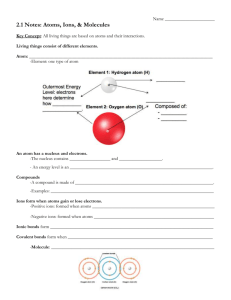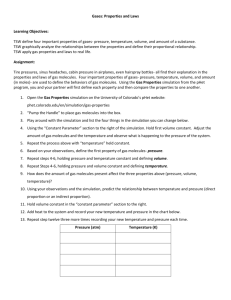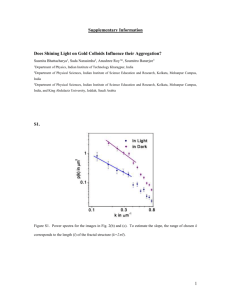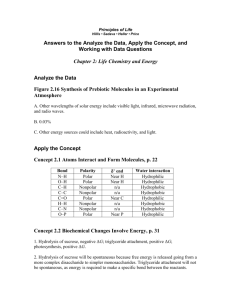Anna Stachiewicz
advertisement
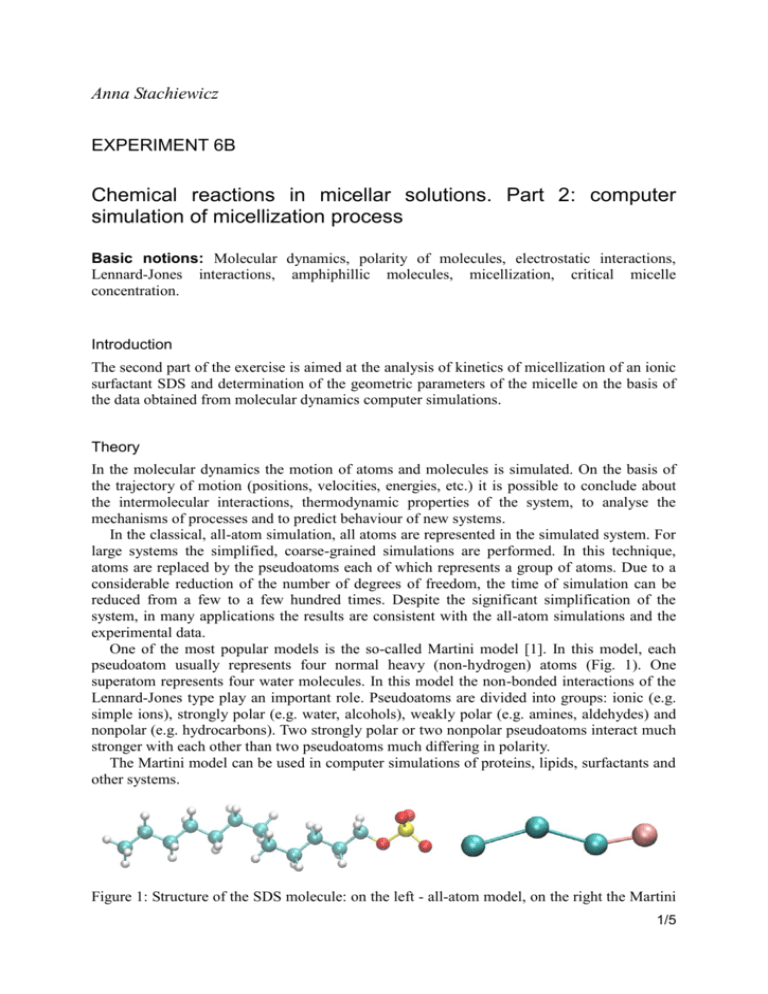
Anna Stachiewicz EXPERIMENT 6B Chemical reactions in micellar solutions. Part 2: computer simulation of micellization process Basic notions: Molecular dynamics, polarity of molecules, electrostatic interactions, Lennard-Jones interactions, amphiphillic molecules, micellization, critical micelle concentration. Introduction The second part of the exercise is aimed at the analysis of kinetics of micellization of an ionic surfactant SDS and determination of the geometric parameters of the micelle on the basis of the data obtained from molecular dynamics computer simulations. Theory In the molecular dynamics the motion of atoms and molecules is simulated. On the basis of the trajectory of motion (positions, velocities, energies, etc.) it is possible to conclude about the intermolecular interactions, thermodynamic properties of the system, to analyse the mechanisms of processes and to predict behaviour of new systems. In the classical, all-atom simulation, all atoms are represented in the simulated system. For large systems the simplified, coarse-grained simulations are performed. In this technique, atoms are replaced by the pseudoatoms each of which represents a group of atoms. Due to a considerable reduction of the number of degrees of freedom, the time of simulation can be reduced from a few to a few hundred times. Despite the significant simplification of the system, in many applications the results are consistent with the all-atom simulations and the experimental data. One of the most popular models is the so-called Martini model [1]. In this model, each pseudoatom usually represents four normal heavy (non-hydrogen) atoms (Fig. 1). One superatom represents four water molecules. In this model the non-bonded interactions of the Lennard-Jones type play an important role. Pseudoatoms are divided into groups: ionic (e.g. simple ions), strongly polar (e.g. water, alcohols), weakly polar (e.g. amines, aldehydes) and nonpolar (e.g. hydrocarbons). Two strongly polar or two nonpolar pseudoatoms interact much stronger with each other than two pseudoatoms much differing in polarity. The Martini model can be used in computer simulations of proteins, lipids, surfactants and other systems. Figure 1: Structure of the SDS molecule: on the left - all-atom model, on the right the Martini 1/5 EXPERIMENT 6B model. The radii of the balls correspond to the van der Waals radii of particular atoms. Chemical reactions in micellar solutions: computer simulation 2/5 EXPERIMENT 6B In water solutions the amphiphillic particles make aggregates (micelles) of different geometry. The shape and size of such aggregates are determined by two types of interactions – the attraction of nonpolar tails and repulsion of the polar heads. The nonpolar hydrophobic fragments of particles are inside the aggregate and are surrounded by the hydrophilic polar parts. The attraction of tails is a consequence of the fact that nonpolar chains interact with one another stronger than with the polar solvent (hydrophobic effect). Non-ionic surfactants make relatively large aggregates, even of up to a few thousand molecules. Ionic surfactants make smaller aggregates of below 100 molecules. The distances between the polar fragments are as long as possible to minimise repulsion but small enough to restrict the penetration of water molecules inside the aggregate [2]. Micelles are most often spherical, but can have other geometry depending on the type and concentration of surfactant and the ionic strength. For the ionic surfactants, the higher the ionic force of the solution (reducing the repulsion of heads with the same sign charges), the higher the probability of formation of large non-spherical structures. The formation of bilayers is promoted by high volume of the nonpolar part of the molecule, e.g. the presence of two chains [2]. Spherical micelles can be described by the approximate model of the oil drop [3, 4]. This model assumes that the density of the interior of the micelle containing hydrocarbon chains is the same as that of the hydrocarbon solution. Moreover, it assumes that the surface of the micelle is homogeneous, the polar heads are uniformly distributed and the number of the heads is the same as the number of the tails. On the basis of the measured density of alkanes, the formula for the volume of a spherical drop of the hydrocarbon, comprising m molecules, has been derived: 3 V = (27.4 + 26.9 Nc) m [Å ], (1) where Nc is the number of carbon atoms in the chain. This volume is also equal to that of the hydrophobic core of the micelle composed of m molecules. The radius of the core is: r = 1.26 Nc + 0.84 [Å]. (2) As the volume of the ball is V = (4/3)πr3 and also V = (27.4 + 26.9Nc)m, the two expressions can be equated to derive the formula for the number of molecules making a micelle as a function of its radius: m (4 / 3)r 3 . 27.4 26.9 N c (3) An important parameter characterising a micelle is the area per one molecule of the compound of which it is made. As the surface area of the ball is S = 4πr2, the following formula can be derived: 27.4 26.9 N c 3(27.4 26.9 N c ) 2 S 4r 2 [Å ]. m r 4 / 3r 3 (4) Practical realisation Computer simulation of SDS aggregation 1. On the desktop make a folder labelled with the student’s name. 2. Enter the folder Symulacje_micele. Chemical reactions in micellar solutions: computer simulation 3/5 EXPERIMENT 6B 3. With the right button of the mouse click on the folder, chosen by the instructor, containing the files for the simulation (e.g. agregacja_310K_50cz) then copy it to the folder on the desktop labelled with your name. 4. Enter the copied folder containing the files for simulation. 5. To start the console (the text field with a dark background) in the Ubuntu system, click with the right key of the mouse on the empty space between the icons and select the option Otwórz w terminalu or Open in terminal. 6. To start the simulation in the NAMD program [5], type the command in the console: charmrun +p2 /usr/bin/namd2 eq.namd The simulation takes about 1 or 2 hours, depending on the speed of the processor. Caution: simulation, visualisation and data analysis should be performed in the same folder labelled with your name. Visualisation of SDS aggregation 1. When the simulation is completed, perform visualisation of the results in the VMD program [6], typing in the console: vmd ionized.psf eq.dcd 2. Select Display → Orthographic 3. In order to see the poorly visible ions present in the system: Select Graphics → Representations... Click Create Rep In the text field Selected Atoms type ions instead of all, confirm From the list Drawing Method select VDW Change the value of Sphere Scale to 0.5 4. By clicking the button play (in the right bottom corner of the window VMD Main) start the visualisation of the simulation. Repeated click on this button stops the display. 5. If the centre of mass of the micelle is significantly shifted with respect to the centre of the box, that is when the micelle is cut across, e.g. one fragment of the micelle is at the bottom of the simulation box, while another one at the top, then: Select Extensions → Tk Console Type the following text as a single command into the Tk Console window: pbc wrap -centersel "resname SDS" -center com -compound residue -all If the centre of mass of the micelle is still shifted, you can either execute again the above command or you can replace resname SDS with e.g. resid 1: pbc wrap -centersel "resid 1" -center com -compound residue -all Instead of number 1, you can choose another one from the range 1-30. Chemical reactions in micellar solutions: computer simulation 4/5 EXPERIMENT 6B To close the program VMD, in the window VMD Main click the cross in the upper right corner and select Yes. Data analysis 1. To start the script (in the Tcl language) for data analysis, type in the console the following command: vmd -e aggregate.tcl -dispdev none 2. The program VMD will start in the text mode. After analysis of the whole trajectory (2000 frames) the script will automatically stop working and will close the program VMD. 3. Draw the plots in the program Python, typing: python plot.py 4. Two plots will be displayed. Save plot 1, by clicking the diskette symbol, type the name of the file (plot_n.png) and confirm. In the same way save plot 2 (plot_r.png). Discussion 1. On the basis of visualisation conclude if the majority of Na+ ions are in the water phase, on the micelle surface or in the core of the micelle. What is the reason for such distribution? 2. From plot 1 read off the mean number of surfactant molecules making an aggregate and the time after which the equilibrium state has been reached, give the result in [ns]. 3. From plot 2 read off the mean radius of the aggregate after reaching the state of equilibrium. Compare it to the theoretical value, calculated from equation 2, if for SDS the value of Nc, (the number of carbon atoms making the hydrocarbon chain inside the micelle) is 12. 4. Calculate the ratio of the aggregate area to the number of molecules making it, (S/m), using the previously determined value of the radius (point 3) and the number of molecules (point 2). Compare it with the theoretical value calculated from equations 2 and i 4. Bibliography [1] S. Marrink; H. Risselada; S. Yefimov; D. Tieleman; A. de Vries, J. Phys. Chem. B, 111 (2007) 7812. [2] P. Atkins, Physical Chemistry. Oxford University Press, Oxford, 2014. [3] C. Tanford, The Hydrophobic Effect: Formation of Micelles and Biological Membranes. Wiley, New York, 1980. [4] http://voh.chem.ucla.edu/vohtar/spring05/classes/156/ [5] http://www.ks.uiuc.edu/Research/namd/ [6] http://www.ks.uiuc.edu/Research/vmd/ Chemical reactions in micellar solutions: computer simulation 5/5
